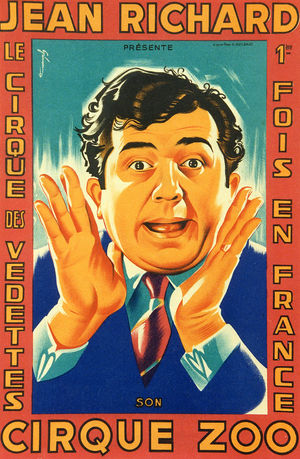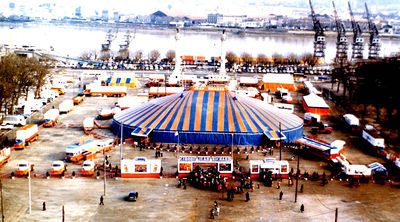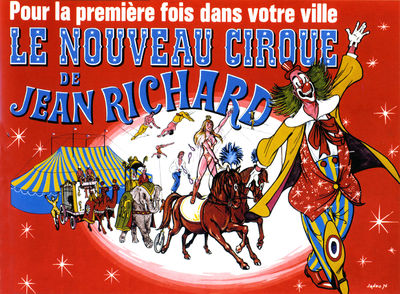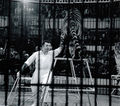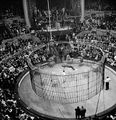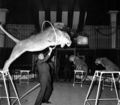Jean Richard
From Circopedia
Actor, Comedian, Circus Owner
By Pierre Fenouillet
It was surely a sign: On April 18, 1921, in Bessines, near Niort (in the southwest of France), Jean Richard (1921-2001) was born in a farm named "La Ménagerie." His father was Pierre Richard, a horse dealer, and his mother a homemaker, née Suzanne Boinot.
His early encounters with circus performers (particularly Martha-la-Corse, a cat trainer(English/American) An trainer or presenter of wild cats such as tigers, lions, leopards, etc.) triggered his enduring passion for animals, especially big cats. When he was only ten years old, he was known to tell people: "When I grow up, I'll have a lion or a tiger in my garden!" In high schoolA display of equestrian dressage by a rider mounting a horse and leading it into classic moves and steps. (From the French: Haute école), Richard, who had a gift for drawing, began trying his hand at caricature: he would soon sell his cartoons to local newspapers.
After World War II, Richard organized German tours for French theatrical companies. He began to make a name for himself performing in a famous postwar Parisian cabaret, L'Amiral. There he developed a successful comic character, that of a jovial and naive peasant from the small imaginary village of Champignol. He also began to work as an actor—in the movies, in the theatre, and in comedies that were sometimes a little cheap. During his long career, he appeared in about eighty films.
His ever-growing popularity allowed him to purchase a vast property in Ermenonville, north of Paris, where he began to gather all sorts of wild animals. His menagerie quickly reached impressive proportions. In order to continue maintaining it, he had to open it to the public in 1956. His private zoological collection, the Zoo d'Ermenonville, became the most important in the country.
His passion for the circus never abated, though. An amateur animal trainer, he presented, in 1955, Rolf Knie's group of African elephants at the Cirque Medrano in Paris. The following year, he presented the liberty"Liberty act", "Horses at liberty": Unmounted horses presented from the center of the ring by an equestrian directing his charges with his voice, body movements, and signals from a ''chambrière'' (French), or long whip. horse-act of Alexis Gruss at the Gala de l'Union des Artistes. (The Gala de l'Union, as it was known, was a "circus of the stars" type of event—an extremely chic Parisian fundraising event benefiting elderly actors.) He would appear again at the Gala de l'Union des Artistes in 1963, this time with a tiger act.
The Cirque Jean Richard
In 1957, his wildest dream came true: he went on tour with a circus bearing his name, put together with the help of the Gruss family. Jean Richard himself presented three acts: a cage act(English/American) Act performed in a cage, such as lion or tiger acts. with a group of lionesses, an elephant act, and a comedy sketch from his days at L'Amiral, The Champignol Orphéon. Ecstatic, he said to a newspaperman: "Each night, when I enter the cage with my cats, I am rewarded for all my efforts and worries." The Cirque Jean Richard hit the road again in 1958, this time without its eponym. (From 1959 onward, the Grusses would tour under the name Grand Cirque de France.)
In 1963, Richard created the first French amusement park on the American model, La Mer de Sable, just a few miles from his zoo. It would be followed in 1966 by a second, western-themed amusement park, La Vallée des Peaux-Rouges, in Fleurines, Oise.Meanwhile, Richard continued to appear as a comic actor in movies and to star on stage in successful musicals. He also performed in theatre and on television—notably in the role of Maigret, the famous detective created by Georges Simenon. Jean Richard impersonated Maigret on television for more than twenty years (1967-90).
1969 saw the concretization of his love of the circus with the launch of his very own Cirque Jean Richard, brand-new from the big topThe circus tent. America: The main tent of a traveling circus, where the show is performed, as opposed to the other tops. (French, Russian: Chapiteau) to the last trailer. The show's success was immediate, and three years later (1972), he bought the Cirque Pinder, the ultimate (and largest) French circus. The greatest artists of the time performed under his big tops, and Richard found himself at the helm of the most important circus enterprise in France.
Gifted with a remarkable capacity for work and an astonishing memory, Jean Richard shuttled continually from TV studio to theatre boards, from his corporate offices to his circuses on the road. To those who asked him how he could do so many things at the same time, he replied: "But I am on a vacation, since I do only things I love!"
The End Of The Road
In May 1973, the machine jammed. A terrible car accident left Jean Richard on the brink of death for three weeks. After that, there would be a "before" and an "after." Richard was obliged to delegate. Even so, the company continued to expand, establishing a permanent big topThe circus tent. America: The main tent of a traveling circus, where the show is performed, as opposed to the other tops. (French, Russian: Chapiteau) in Paris, the Nouvel Hippodrome de Paris (1974-1982). In 1974, it launched Expédition Jungle, a short-lived itinerant menagerie, and in 1976, a third touring unit named Nouveau Cirque Jean Richard, later renamed Medrano, with the blessing of Jérôme Medrano. Despite its growth, the company had become a giant with feet of clay.In 1978, a first alarm led to a complete reorganization of the company and to serious downsizing and financial cuts: The third unit (by then called Medrano) disappeared in June, in the middle of the season. But it was only a deferred sentence: The company filed for bankruptcy in 1983, and the remaining circuses (Pinder and Jean Richard) were bought lock, stock, and barrel, by a former associate, Gilbert Edelstein.
Jean Richard retired as an actor in 1990. He became a sort of "wise old man" of the French circus. By dint of sacrifice, sheer will power, and most of all, passion, he had returned to the French circus its pride and respectability and made it possible for the French government to recognize the circus as a bona fide performing art.
Jean Richard died on December 12, 2001, orphaning an entire generation of circus enthusiasts to whom he soon became a cult figure. (Some of these enthusiasts stand today at the helms of major French circuses.) In 2021 they celebrated the hundredth anniversary of his birth with a series of manifestations and dedications in Bessines, Jean Richard's birthplace, and Ermenonville, where he lived.
Suggested Reading
- Jean Richard, Mes bêtes à moi (Paris, Fernand Nathan, 1969)
- Jean Richard, Envoyez les Lions (Paris, Fernand Nathan, 1971)
- Jean Richard, Ces animaux qu'on appelle des bêtes (Paris, Fernand Nathan, 1971)
- Jean Richard, Ma vie sans filet (Paris, Robert Laffont, 1984) ISBN 2-221-01209-7
- Pierre Fenouillet, Jean Richard et son cirque, ou l'histoire d'une passion (Vieux Boucau, Éditions du Nez Rouge, 1998)
- Pierre Fenouillet, Jean Richard, le risque-tout du spectacle (Talence, Editions Bastingage, 2011) ISBN 978-2-35060-022-2
- Pierre Fenouillet, Les Clowns chez Jean Richard (Tresses, Éditions du Nez Rouge, 2018)
See Also
- Video: Jean Richard, lion act, at the Gala de l'Union des Artistes (1969)
- Video: Jean Richard, horse act, at the Gala de l'Union des Artistes (1974)
- Video: Gens du Voyage, TV Documentary, featuring Jean Richard and Jean Pierre Richard (1979)
